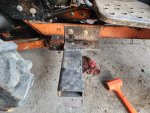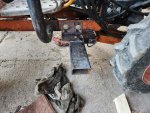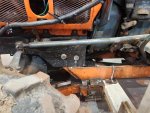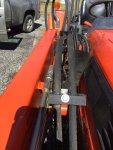trial and error
Well-known member
Equipment
B7100dt manual trans. homemade FEL, 4 way hydraulic dozer blade
Yes, I know build and budget shouldn't really be in the same headline but my funds are pretty limited and im tired of not having a FEL on the ol gear drive b7100 which is already tapped for hydraulics and already has a (very) similar subframe to the b219 loader to which a full hydraulic plow is already mounted. Besides anything has got to be better then a wheelbarrow and shovel with a 400' gravel drive to maintain etc
This is going to be an test of my fabricobblication skills and more a of a test of if can I come out at the end with something functional after spending a fair amount of time and $. What else would you expect from someone with the title of "trial and error"
others have already commented that the "hard part of my plan is already done for me" in that I already have 80-90% of the subframe I need. and that with some simple modifications it will work for my build. I've mocked up what I can using wood (no good pictures of that sorry) for the loader arms etc and have moved on to starting the metal fabrication process. I only have a gasless mig 125 which I modified with a bridge rectifier to get a more stable arc, a drill press, 2 angle grinders, a metal chop saw and a fairly unlimited hand tool assortment. A plasma cutter, mill, lathe, 220 volt welder and on and on would be super awesome to have, however that would be my entire budget and then some without even starting the fab process I'm fairly confident in my skills and although prettty primitive I think I can come out on the other side of this with a fairly functional full hydro boom and curl FEL. Another bonus is I've already got a 2 stick 2 spool valve with float for the plow so while a joystick controller would be super, for now I'm going to stick with what I've already got until I know this project is worth any extra funds not absolutely nessacary.
Build materials are 2x4"×1/8" rectangle tube for most major components, 2x2"x1/8" square tube for tower bracing etc and 2×4"×3/16 rectangle tube for the peice that runs under the tractor for the tower mounts. 3/16 plate for braces at joints and cylinder mounts etc. Some kind of bushings (haven't gotten that far in my planning yet). Cylinders are cross tube 1" shaft x18" for boom and 1" shaft 16" for curl (rugged made. For the win on those) I'm not looking to lift the world so they should be fine based on some quick hydro calculators online. Couple small shaft cylinders and limited counterweight it should keep me from breaking the only tractor I have.
Below are couple pictures of my progress so far
I'm open to suggestions/ comments but this is a bare bones build lol so don't mind the hideous welds and non OSHA aproved methods along the way
This is going to be an test of my fabricobblication skills and more a of a test of if can I come out at the end with something functional after spending a fair amount of time and $. What else would you expect from someone with the title of "trial and error"
others have already commented that the "hard part of my plan is already done for me" in that I already have 80-90% of the subframe I need. and that with some simple modifications it will work for my build. I've mocked up what I can using wood (no good pictures of that sorry) for the loader arms etc and have moved on to starting the metal fabrication process. I only have a gasless mig 125 which I modified with a bridge rectifier to get a more stable arc, a drill press, 2 angle grinders, a metal chop saw and a fairly unlimited hand tool assortment. A plasma cutter, mill, lathe, 220 volt welder and on and on would be super awesome to have, however that would be my entire budget and then some without even starting the fab process I'm fairly confident in my skills and although prettty primitive I think I can come out on the other side of this with a fairly functional full hydro boom and curl FEL. Another bonus is I've already got a 2 stick 2 spool valve with float for the plow so while a joystick controller would be super, for now I'm going to stick with what I've already got until I know this project is worth any extra funds not absolutely nessacary.
Build materials are 2x4"×1/8" rectangle tube for most major components, 2x2"x1/8" square tube for tower bracing etc and 2×4"×3/16 rectangle tube for the peice that runs under the tractor for the tower mounts. 3/16 plate for braces at joints and cylinder mounts etc. Some kind of bushings (haven't gotten that far in my planning yet). Cylinders are cross tube 1" shaft x18" for boom and 1" shaft 16" for curl (rugged made. For the win on those) I'm not looking to lift the world so they should be fine based on some quick hydro calculators online. Couple small shaft cylinders and limited counterweight it should keep me from breaking the only tractor I have.
Below are couple pictures of my progress so far
I'm open to suggestions/ comments but this is a bare bones build lol so don't mind the hideous welds and non OSHA aproved methods along the way
Attachments
-
897.4 KB Views: 383
-
892 KB Views: 385
-
496.7 KB Views: 377
Last edited:





